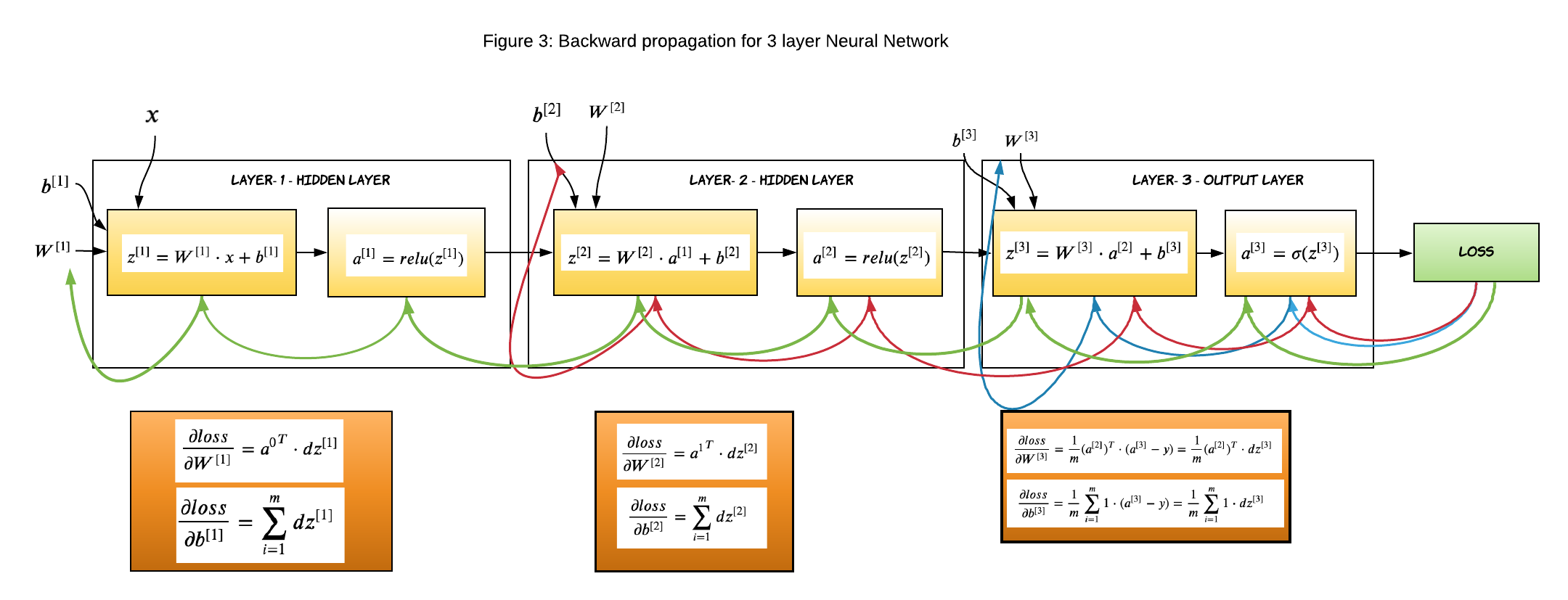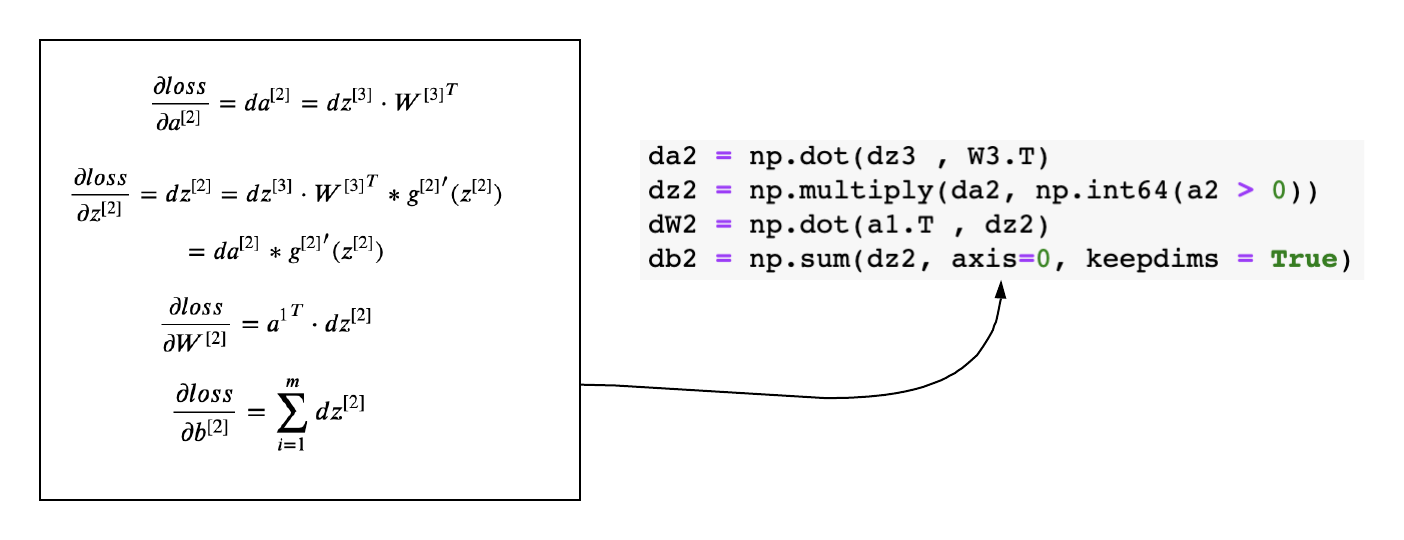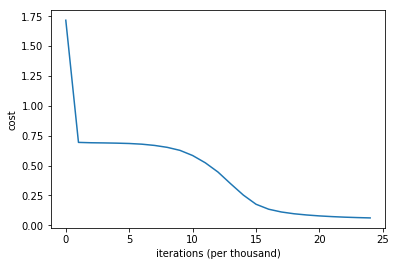Implementing Neural Network Algorithm with NumPy
Introduction
In the previous article, I went over the math behind Neural Network. We have seen how to do forward propagation, then computed the loss function and went through the math behind the backward propagation in details. In this article we will implement a neural network from scratch in python.
We will be training 3-layer neural network with two hidden layer and one output layer (remember, we don’t consider input in the layer count). The hidden layers will have RELU activation function whereas the output layer will have sigmoid activation function. The code for this article is available here as a Jupyter notebook, feel free to download and try it out yourself.
Before we go any further, let’s look at the structure of the neural network we are going to build.

For a L layer neural network, which has L-1 hidden layers and 1 output layer, the parameters (weights and biases) of the layer l are represented as:
-
$W^{[l]}$: Weight matrix of dimension (size of layer $l-1$, size of layer $l$)
-
$b^{[l]}$: Bias vector of dimension (1, size of layer $l$)
In addition to weights and biases, during the training process, following intermediate variables are computed:
-
$Z^{[l]}$: Linear Activation of layer l.
-
$g^{[l]}(.)$ : Non-linear function
-
$A^{[l]}$: Non-linear activation. Output of $g^{[l]}(Z^{[l]})$ , where $A^{[0]}$ is the input data X.
Gradient Descent Algorithm Recap
Training a neural network consists of 4 steps:
-
Initialize weights and biases.
-
Forward propagation: Using the input X, weights W and biases b, for every layer we compute Z and A. At the final layer, the activation function gives the prediction $\widehat{y}$.
-
Compute the loss function: This is a function of the actual label y and predicted label $\widehat{y}$. It captures how far off our predictions are from the actual target. Our objective is to minimize this loss function.
-
Backward Propagation: In this step, we calculate the gradients of the loss function f(y, $\widehat{y}$) with respect to A, W, and b called dA, dW and db. Using these gradients, we update the values of the parameters from the last layer to the first.
-
Repeat steps 2–4 for n iterations/epochs till we feel we have minimized the loss function, without overfitting the train data.
Import Dependencies
import numpy as np # linear algebra
import matplotlib.pyplot as plt
import sklearn
import sklearn.datasets
Load Dataset
For the purpose of this post, let’s assume we have a dataset of 1000 records and two features. We will use a sample circle dataset using scikit learn.
def load_dataset():
np.random.seed(4)
train_X, train_Y = sklearn.datasets.make_circles(n_samples=1000, noise=.05)
np.random.seed(2)
test_X, test_Y = sklearn.datasets.make_circles(n_samples=100, noise=.05)
# Visualize the data
plt.scatter(train_X[:, 0], train_X[:, 1], c=train_Y, s=40, cmap=plt.cm.Spectral);
train_Y = train_Y.reshape((train_Y.shape[0],1))
test_Y = test_Y.reshape((test_Y.shape[0],1))
return train_X, train_Y, test_X, test_Y
train_X, train_Y, test_X, test_Y = load_dataset()

Initialize Weights and Biases
The weights $W^{[l]}$ should be initialized randomly to break symmetry. It is however okay to initialize the biases $b^{[l]}$ to zeros. Symmetry is still broken so long as $W^{[l]}$ is initialized randomly.
We will initialize the weights from a random normal distribution. Biases are initialized to zero. The dimension of the weight matrix should be number of nodes (or neurons) in the previous layer by number of nodes in the current layer. Since the 0th layer is the input layer, we will consider the number of features instead of nodes.
def init_weights(layers_dims):
"""
Initialize the weights from a random normal distribution
Biases are initialized to zero
W1 -- weight matrix of shape (layers_dims[0], layers_dims[1])
b1 -- bias vector of shape (1,Initialize the weights from a random normal distribution)
...
WL -- weight matrix of shape (layers_dims[L-1], layers_dims[L])
bL -- bias vector of shape (1 , layers_dims[L])
"""
params={}
np.random.seed(4) # Seed the random number generator
L = len(layers_dims) # integer representing the number of layers
for l in range(1, L):
params['W' + str(l)] = np.random.randn(layers_dims[l-1], layers_dims[l])
params['b' + str(l)] = np.zeros((1,layers_dims[l]))
return params
Forward Propagation
Considering $X$ as Layer-0, $X$ can be represented as $A^{[0]}$. We can generalize the forward propagation equations for Layer-l as:
\[\large \bbox[10px, border: 2px solid black]{ Z^{[l]} = A^{[l-1]} \cdot W^{[1]} + b^{[1]} }\] \[\large \bbox[10px, border: 2px solid black]{ A^{[l]} = g^{[l]}(Z^{[l]}) }\]For the first two layers we will use RELU as activation function and for the output layer we will be using SIGMOID activation function.
Sigmoid is an activation function of form f(x) = 1 / 1 + exp(-x). Its Range is between 0 and 1. Relu stands for Rectified Linear Units. The formula is deceptively simple: f(x) = max(0,x)

def relu(z):
return np.maximum(0, z)
def sigmoid(z):
return 1.0 / (1.0 + np.exp(-z))
def forward_propagation(X,params):
W1 = params["W1"]
b1 = params["b1"]
W2 = params["W2"]
b2 = params["b2"]
W3 = params["W3"]
b3 = params["b3"]
# LINEAR -> RELU -> LINEAR -> RELU -> LINEAR -> SIGMOID
z1 = np.dot(X , W1) + b1
a1 = relu(z1)
z2 = np.dot(a1 , W2) + b2
a2 = relu(z2)
z3 = np.dot(a2 , W3) + b3
a3 = sigmoid(z3)
cache = (z1, a1, W1, b1, z2, a2, W2, b2, z3, a3, W3, b3)
return a3, cache
Note: We are returning all values computed in forward propagation in cache because we will be using them to calculate the derivatives during backward propagation.
Compute Loss
All right, we had the actual values of y for each training example and now we have calculated the predicted values of y (the output of the third layer, a3 in our case). It’s time to calculate the loss, the loss function used in classification of neural network is cross entropy loss. For a sample size of m records, the cost function is defined as:
\[\bbox[10px, border: 2px solid black]{\large J(W,b) = \frac{1}{m} \displaystyle\sum_{i=1}^{m} -y_i \cdot \log(\widehat{y_i}) - (1-y_i) \cdot log(1-\widehat{y_i})}\]def compute_loss(y, yhat):
m = y.shape[0]
logprobs = np.multiply(-np.log(yhat),y) + np.multiply(-np.log(1 - yhat), (1 - y))
loss = 1./m * np.nansum(logprobs)
return loss
Backward Propagation
Unlike forward propagation, the gradients are calculated from right to left. That means we will start from the output layer and gradually proceed inward. I will not dig deep in the back propagration logic, rather I will bring back the equations we computed in my previous article and write code corresponding to them. I strongly suggest you go over backpropagation math here if you don’t understand how it works completely.

Gradients of Layer-3
This is the outer layer where we calculate the gradient of the sigmoid activation function. The below equations were derived in my previous article, we will just apply them to the code.

The generic logic to calculate gradient for layer L
If you look closely at the gradients of each layer, you will find a pattern and that makes it so very easy to define the equations and code it.
\[\frac{\partial loss}{\partial a^{[L]}}= da^{[L]} = dz^{[L+1]} \cdot {W^{[L+1]}}^T\] \[\begin{equation} \frac{\partial loss}{\partial z^{[L]}}= dz^{[L]} = da^{[L]}* {g^{[L]}}^{\prime}(z^{[L]}) \end{equation}\] \[\frac{\partial loss}{\partial W^{[L]}}= dW^{[L]} = {a^{[L-1]}}^T \cdot dz^{[L]}\] \[\frac{\partial loss}{\partial b^{[L]}} = \displaystyle\sum_{i=1}^{m} dz^{[L]}\]Gradients of Layer-2
The above generic equations can be applied to layer-2 and layer - 1 and derive the gradients easily.

Gradients of Layer-1

def back_propagation(X,y,cache):
m = X.shape[0]
(z1, a1, W1, b1, z2, a2, W2, b2, z3, a3, W3, b3) = cache
dz3 = 1./m * (a3 - y)
dW3 = np.dot(a2.T ,dz3)
db3 = np.sum(dz3, axis=0, keepdims = True)
da2 = np.dot(dz3 , W3.T)
dz2 = np.multiply(da2, np.int64(a2 > 0))
dW2 = np.dot(a1.T , dz2)
db2 = np.sum(dz2, axis=0, keepdims = True)
da1 = np.dot(dz2, W2.T)
dz1 = np.multiply(da1, np.int64(a1 > 0))
dW1 = np.dot(X.T , dz1 )
db1 = np.sum(dz1, axis=0, keepdims = True)
gradients = {"dz3": dz3, "dW3": dW3, "db3": db3,
"da2": da2, "dz2": dz2, "dW2": dW2, "db2": db2,
"da1": da1, "dz1": dz1, "dW1": dW1, "db1": db1}
return gradients
Update Parameters
Once we have calculated the gradients, the last step is to update the weights with the derivative of the loss function.
def update_parameters(grads,params,learning_rate):
L = len(params) //2
# Update rule for each parameter
for k in range(L):
params["W" + str(k+1)] = params["W" + str(k+1)] - learning_rate * grads["dW" + str(k+1)]
params["b" + str(k+1)] = params["b" + str(k+1)] - learning_rate * grads["db" + str(k+1)]
return params
def accuracy(y, yhat):
acc = sum(y == np.round(yhat)) / len(y)
return acc
Putting it all Together
We have successfully built all components for the neural network. It’s time to run the network and monitor the performance. We will run the network for 25000 iterations with a learning rate of 0.01. You will obeserve that the cost slowly goes down and accuracy improves with each iteration.
def model (X, y, layers=[], learning_rate=0.01, iterations=100):
grads = {}
costs = []
acc=0
#initialize weights and bias
parameters = init_weights(layers)
for i in range(0, iterations):
# Forward propagation: LINEAR -> RELU -> LINEAR -> RELU -> LINEAR -> SIGMOID.
a3, cache = forward_propagation(X,parameters)
# Compute Loss
cost = compute_loss(y,a3)
acc = accuracy(y, a3)
# Backward propagation.
grads = back_propagation(X,y, cache)
# Update parameters.
parameters = update_parameters( grads,parameters,learning_rate)
# Print the loss every 1000 iterations
if i % 1000 == 0:
print("Cost after iteration {}: {} and accuracy: {}".format(i, cost,acc))
costs.append(cost)
return costs, parameters
layers_dims = [train_X.shape[1], 10, 5, 1]
costs, parameters = model(train_X,train_Y,layers_dims, learning_rate=0.01, iterations = 25000)
# plot the loss
plt.plot(costs)
plt.ylabel('cost')
plt.xlabel('iterations (per thousand)')
#plt.title("Learning rate =" + str(learning_rate))
plt.show()
Cost after iteration 0: 1.7162788190920542 and accuracy: [0.5]
Cost after iteration 1000: 0.6935455829889666 and accuracy: [0.499]
Cost after iteration 2000: 0.6905406067392547 and accuracy: [0.514]
Cost after iteration 3000: 0.6891434906598779 and accuracy: [0.507]
Cost after iteration 4000: 0.6872602776622828 and accuracy: [0.508]
Cost after iteration 5000: 0.6843228956957375 and accuracy: [0.529]
Cost after iteration 6000: 0.6785453392737052 and accuracy: [0.54]
Cost after iteration 7000: 0.6681373938207664 and accuracy: [0.564]
Cost after iteration 8000: 0.6520194184819957 and accuracy: [0.637]
Cost after iteration 9000: 0.6269290706018096 and accuracy: [0.697]
Cost after iteration 10000: 0.5837699313056273 and accuracy: [0.789]
Cost after iteration 11000: 0.5227492398023532 and accuracy: [0.869]
Cost after iteration 12000: 0.4453596672561303 and accuracy: [0.899]
Cost after iteration 13000: 0.3471519362950478 and accuracy: [0.922]
Cost after iteration 14000: 0.2524945791460992 and accuracy: [0.943]
Cost after iteration 15000: 0.1756322160294124 and accuracy: [0.973]
Cost after iteration 16000: 0.133940394970139 and accuracy: [0.98]
Cost after iteration 17000: 0.1108204618355506 and accuracy: [0.981]
Cost after iteration 18000: 0.09593921456847519 and accuracy: [0.982]
Cost after iteration 19000: 0.08573565591788658 and accuracy: [0.983]
Cost after iteration 20000: 0.07799445785668417 and accuracy: [0.983]
Cost after iteration 21000: 0.07210646851378232 and accuracy: [0.983]
Cost after iteration 22000: 0.06745702537404373 and accuracy: [0.983]
Cost after iteration 23000: 0.06398162234062926 and accuracy: [0.983]
Cost after iteration 24000: 0.0612092147947077 and accuracy: [0.982]

Final Thoughts
In this article we reviewd the logic of implementing a feed forward neural network and implemented one in python. I hope you have found this post useful. Happy learning :)
The complete Neural Network
class NeuralNet():
"""
Implements a three-layer neural network: LINEAR->RELU->LINEAR->RELU->LINEAR->SIGMOID.
Arguments:
X -- input data, of shape (number of examples,number of features)
Y -- true "label" vector of shape (number of examples,1)
layers -- A list containing number of neurons in each layer starting with input layer
learning_rate -- learning rate for gradient descent
num_iterations -- number of iterations to run gradient descent
print_cost -- if True, print the cost every 1000 iterations
"""
def __init__(self, layers=[], learning_rate=0.001, iterations=100,print_cost = True):
self.params = {}
self.learning_rate = learning_rate
self.iterations = iterations
self.print_cost=print_cost
self.costs = []
self.layers_dims = layers
self.n_samples = None
self.X = None
self.y = None
def init_weights(self):
"""
Initialize the weights from a random normal distribution
Biases are initialized to zero
W1 -- weight matrix of shape (layers_dims[0], layers_dims[1])
b1 -- bias vector of shape (1,Initialize the weights from a random normal distribution)
...
WL -- weight matrix of shape (layers_dims[L-1], layers_dims[L])
bL -- bias vector of shape (1 , layers_dims[L])
"""
np.random.seed(1) # Seed the random number generator
L = len(self.layers_dims) # integer representing the number of layers
for l in range(1, L):
self.params['W' + str(l)] = np.random.randn(self.layers_dims[l-1], self.layers_dims[l])
self.params['b' + str(l)] = np.zeros((1,self.layers_dims[l]))
def relu(self,z):
'''
The ReLufunction performs a threshold
operation to each input element where values less
than zero are set to zero.
'''
return np.maximum(0, z)
def sigmoid(self,z):
'''
The sigmoid function takes in real numbers in any range and
squashes it to a real-valued output between 0 and 1.
'''
return 1.0 / (1.0 + np.exp(-z))
def compute_loss(self, yhat):
"""
Implement the loss function
Arguments:
yhat -- post-activation, output of forward propagation
Returns:
loss - value of the loss function
"""
m = self.n_samples
logprobs = np.multiply(-np.log(yhat),self.y) + np.multiply(-np.log(1 - yhat), 1 - self.y)
loss = 1./m * np.nansum(logprobs)
return loss
def forward_propagation(self,X):
"""
Implements the forward propagation .
Arguments:
X -- input dataset, of shape ( number of examples,input size)
Returns:
a3 -- the predicted output
"""
W1 = self.params["W1"]
b1 = self.params["b1"]
W2 = self.params["W2"]
b2 = self.params["b2"]
W3 = self.params["W3"]
b3 = self.params["b3"]
# LINEAR -> RELU -> LINEAR -> RELU -> LINEAR -> SIGMOID
z1 = np.dot(X , W1) + b1
a1 = self.relu(z1)
z2 = np.dot(a1 , W2) + b2
a2 = self.relu(z2)
z3 = np.dot(a2 , W3) + b3
a3 = self.sigmoid(z3)
cache = (z1, a1, W1, b1, z2, a2, W2, b2, z3, a3, W3, b3)
return a3, cache
def back_propagation(self,cache):
"""
Implement the backward propagation.
Arguments:
X -- input dataset, of shape (input size, number of examples)
Y -- true "label" vector (0 for red-dots and 1 for blue-dots)
cache -- cache output from forward_propagation()
Returns:
gradients -- A dictionary with the gradients with respect to each parameter, activation and pre-activation variables
"""
m = self.n_samples
(z1, a1, W1, b1, z2, a2, W2, b2, z3, a3, W3, b3) = cache
dz3 = 1./m * (a3 - self.y)
dW3 = np.dot(a2.T ,dz3)
db3 = np.sum(dz3, axis=0, keepdims = True)
da2 = np.dot(dz3 , W3.T)
dz2 = np.multiply(da2, np.int64(a2 > 0))
dW2 = np.dot(a1.T , dz2)
db2 = np.sum(dz2, axis=0, keepdims = True)
da1 = np.dot(dz2, W2.T)
dz1 = np.multiply(da1, np.int64(a1 > 0))
dW1 = np.dot(self.X.T , dz1 )
db1 = np.sum(dz1, axis=0, keepdims = True)
gradients = {"dz3": dz3, "dW3": dW3, "db3": db3,
"da2": da2, "dz2": dz2, "dW2": dW2, "db2": db2,
"da1": da1, "dz1": dz1, "dW1": dW1, "db1": db1}
return gradients
#Update the coefficients
def update_parameters(self, grads):
"""
Update parameters using gradient descent
Arguments:
grads -- python dictionary containing your gradients, output of n_model_backward
Returns:
parameters -- python dictionary containing your updated parameters
parameters['W' + str(i)] = ...
parameters['b' + str(i)] = ...
"""
L = len(self.params) // 2 # number of layers in the neural networks
# Update rule for each parameter
for k in range(L):
self.params["W" + str(k+1)] = self.params["W" + str(k+1)] - self.learning_rate * grads["dW" + str(k+1)]
self.params["b" + str(k+1)] = self.params["b" + str(k+1)] - self.learning_rate * grads["db" + str(k+1)]
def fit(self, X, y):
'''
Trains the neural network using the specified data and labels
'''
grads = {}
self.n_samples= X.shape[0]
self.X = X
self.y = y
self.init_weights() #initialize weights and bias
for i in range(0, self.iterations):
# Forward propagation: LINEAR -> RELU -> LINEAR -> RELU -> LINEAR -> SIGMOID.
a3, cache = self.forward_propagation(self.X)
# Loss
cost = self.compute_loss(a3)
# Backward propagation.
grads = self.back_propagation( cache)
# Update parameters.
self.update_parameters( grads)
# Print the loss every 1000 iterations
if self.print_cost and i % 1000 == 0:
print("Cost after iteration {}: {}".format(i, cost))
self.costs.append(cost)
def predict(self, X,y):
"""
This function is used to predict the results of a n-layer neural network.
Arguments:
X -- data set of examples you would like to label
parameters -- parameters of the trained model
Returns:
p -- predictions for the given dataset X
"""
# Forward propagation
pred,cache = self.forward_propagation(X)
acc= self.acc(y, np.round(pred))
# print results
print("Accuracy: " ,acc)
return np.round(pred)
def acc(self, y, yhat):
'''
Calculates the accutacy between the predicted valuea and the truth labels
'''
acc = int(sum(y == yhat) / len(y) * 100)
return acc
def plot_loss(self):
'''
Plots the loss curve
'''
plt.plot(self.costs)
plt.xlabel("Iteration")
plt.ylabel("logloss")
plt.title("Loss curve for training")
plt.show()
def getCosts(self):
return self.costs
def getParameters(self):
return self.params
